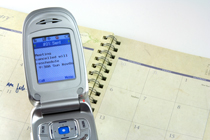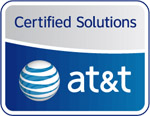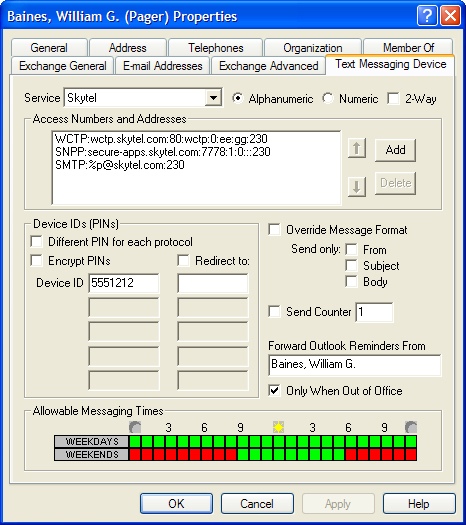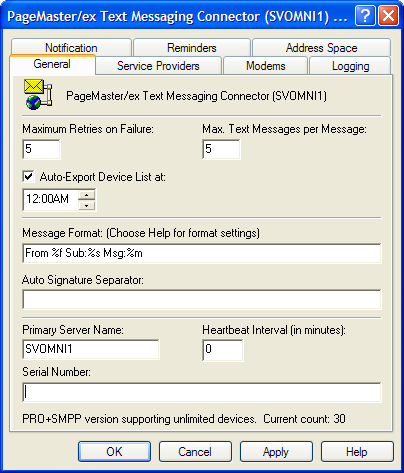

![]() With
PageMaster/ex 2003 Version 11, your entire organization can send text messages,
pages, and SMS (cellular) messages using Microsoft Exchange 2003 or Exchange
2000 Server. Exchange users may send or forward messages to “text messaging
recipients”. These recipients appear on global or personal address lists just
as would any other type of recipient.
With
PageMaster/ex 2003 Version 11, your entire organization can send text messages,
pages, and SMS (cellular) messages using Microsoft Exchange 2003 or Exchange
2000 Server. Exchange users may send or forward messages to “text messaging
recipients”. These recipients appear on global or personal address lists just
as would any other type of recipient.
Text messages can be sent individually or batched to to multiple devices or pre-defined groups of devices. The gateway also handles a mix of numeric and alphanumeric devices in the same group, sending just the numeric portions of a message to the numeric devices and the full message text to alphanumeric devices.
Text messages are transmitted to a service provider using one of six protocols; TAP, SNPP, WCTP, SMPP, SMTP, and DTMF.
Using the "Inbox Rules" or "Out-of-Office Assistant" in Microsoft Outlook, Exchange users can forward some or all of their Email messages to their pager or cellular phone.
 PageMaster/ex can also monitor the appointment reminders for
selected users and forward these reminders as text messages to their
pager or cellular phone.
PageMaster/ex can also monitor the appointment reminders for
selected users and forward these reminders as text messages to their
pager or cellular phone.
PageMaster/ex 2003 is available in three versions; Standard, Pro, and Pro+SMPP. The Pro version adds support for the SNPP,
SMTP, and WCTP
protocols, 2-Way devices, and an enterprise-grade text messaging
engine. The Pro version text messaging engine allows multiple
access methods for each service provider. For example, you can
specify that a  service provider be reached primarily through their
SNPP server. If the SNPP server is down, or if your Internet connection
is down, PageMaster/ex will automatically fall back to alternate
access numbers and protocols.
service provider be reached primarily through their
SNPP server. If the SNPP server is down, or if your Internet connection
is down, PageMaster/ex will automatically fall back to alternate
access numbers and protocols.
Support for the SMPP protocol is available as an add-on to the PRO version.
A version of PageMaster/ex to support Exchange 2010 can be found here. A version of PageMaster/ex to support Exchange 2007 can be found here. A version of PageMaster/ex to support Exchange 5.5 and lower can be found here.
Exchange users may send or forward messages to "text messaging recipients." These recipients appear on global or personal address lists just as would any other type of recipient.

Messages can be sent individually or batched to to multiple devices or pre-defined groups of devices. The gateway also handles a mix of numeric and alphanumeric devices in the same group, sending just the numeric portions of a message to the numeric devices and the full message text to alphanumeric devices.
Exchange users can monitor their Exchange Inbox for new messages. Email messages can selectively be forwarded to their pager or cell phone based on mail filters defined using either the "Inbox Rules" or "Out-of-Office Assistant" in Microsoft Outlook. These filters allow the user to select which of their messages should be sent to their pager or cell phone by defining parameters such as keywords to search for in the From, To, Subject, and Body fields of a message.
PageMaster/ex 2003 will report back to the originator of the message any problems encountered while trying to deliver a text message.
For text messages sent with a receipt requested, PageMaster/ex will send a reply once the message has been successfully sent to the destination device(s).
PageMaster/ex 2003 supports both numeric and alphanumeric pagers and cellular phones... even simultaneously. For example, suppose a user were to send the message "Please call the Farmington supervisor at 555-1212." to a group of pagers that included a mix of numeric and alphanumeric pagers. The full text of the message would be delivered to the alphanumeric pagers, and the message "555-1212" would be sent to the numeric pagers.
PageMaster/ex 2003 does not impose a limit on the length of text messages that may be sent. PageMaster/ex 2003 will automatically split lengthy messages and send them in smaller individual messages that the service provider will permit.
PageMaster/ex 2003 is designed to handle the text messaging needs of even the largest enterprise. Text messages will be batch processed when possible. If 20 text message requests are received and 15 of them are for alpha pagers from the same service provider, all 15 message can be sent in a single connection. The remaining 5 would be sent individually.

All administration of text messaging devices, and configuration of the gateway, is accomplished using the Microsoft Management Console. There is no need to execute and learn and additional software. Installation is quick and simple.
PageMaster/ex 2003 requires at least one Hayes-compatible 2400 baud or faster modem for operation with TAP and DTMF protocols. Multiple modems are supported for load balancing and fault-tolerance.
PageMaster/ex 2003 can also process all of the text messaging required by other PageMaster products installed on the network. In this way, PageMaster/ex 2003 can act as a text messaging server.
General |
|||
| Name: | PageMaster/ex 2003 | ||
| Version: | 11.0 | ||
| Released: | 2008 | ||
System Requirements |
|||
| Processor: | Intel | ||
| Operating System: | Windows 2003 or Windows 2000 Server | ||
| Memory: | 512mb Minimum | ||
| Modem: | At least one Hayes-compatible 2400 baud or faster required for TAP and DTMF protocols. Up to 255 modems supported for load balancing and fault-tolerance | ||
| Internet Connectivity: | A WinSock-compatible Internet connection is required for the SNPP, SMPP, SMTP, and WCTP protocols | ||
| Mail Server: | Microsoft Exchange 2003 or Exchange 2000 Server | ||
Devices |
|||
| Types: | Alphanumeric Pagers (1 and 2-Way), Cellular Phones (SMS 1 and 2-Way), Numeric Pagers | ||
| Number: | Up to unlimited, based on licensing | ||
| Protocols: | Numeric Pagers: DTMF with user
adjustable delay, TAP, SNPP, and WCTP. 1-Way Alphanumeric Pagers: TAP with password support, SNPP, WCTP, SMPP, SMTP. 2-Way Alphanumeric Pagers (PRO version only): SNPP, WCTP, SMPP. 1-Way Cellular Phone : TAP, SNPP, WCTP, SMPP, SMTP. 2-Way Cellular Phone (PRO version only): SNPP, WCTP, SMPP. |
||
Message Handling |
|||
| Batch Sending: | Alphanumeric messages sent to devices sharing a common access method are issued in a single session | ||
| Message Length: | Unlimited. Messages are automatically split and delivered to a device in separate messages according to a maximum message length (user definable) | ||
| Error Correction: | Full error detection and recovery on all protocols. Includes dial-tone detection and busy signal redial for TAP | ||
| Confirmation: | If a message is sent with receipt requested, sender will receive a confirmation Email (Delivery Report) once the message is transmitted successfully | ||
| Error Notification: | If an error is encountered sending a message, a return Email message (Non-Delivery Report) will be issued notifying the sender of the problem. Full error details are logged in the server's application event log | ||
| Backup Protocols: | Multiple protocols may be specified for each service provider. Automatic fallback to alternate protocols upon failure | ||
| Logging: | All text messages sent and failed are logged. Log files are user configurable as to content and organization. | ||
Messaging Methods |
|||
| Email: | Email messages may be sent to the connector either internally (i.e. by and Outlook client) or externally (i.e. through an SMTP connector) | ||
| Desktop Clients: | Text messages sent from client copies of PageMaster | ||
| Outlook Reminders: | Outlook appointment reminders can be forwarded as text messages to devices. | ||
| COM Interface: | Text messages may be sent using a COM interface. | ||
Please contact us for pricing information regarding this product.
PageMaster/ex Version 11 adds the following new features:
Stand-Alone Device Administrator - In previous version of PageMaster/ex 2003, device administration could be performed only with Active Directory Users & Computers (ADU&C).
This release adds a stand-alone administrative tool that can be deployed anywhere on the network for creation, administration, and deletion of devices. The machine on which the tool is installed need NOT have either the Exchange Remote Administration tools nor Active Directory tools. The stand-alone administration can run independently, accessing AD through LDAP calls.
Stand-Alone Connector Administrator - In previous version of PageMaster/ex 2003, connector administration could be performed only with Exchange System Manager (ESM).
This release adds a stand-alone administrative tool that can be deployed anywhere on the network for administration of PageMaster/ex connectors (both 2003 and 2007 versions). The machine on which the tool is installed need NOT have either the Exchange Remote Administration tools nor Active Directory tools. The stand-alone administration can run independently, accessing AD through LDAP calls.
This allows you to assign connector administrative tasks to users that should not
have access to Exchange and/or AD tools.
Client Message Status - PageMaster/ex 2003 now supports bidirectional communication with PageMaster clients.
In prior releases, if a message were to fail, the PageMaster/ex 2003 connector would
log the failure on the server end, and generate an event log error specifying the
cause. However, the message originator at the client end would not be notified of
the failure.
Version 11 now adds the ability for the PageMaster/ex 2003 connector to send failure notifications back to the client for display.
High-availability is the focus of the v10 release. With v10, it is possible to provide text messaging capability should Exchange, AD (Active Directory), or even the entire network, go down.
This is accomplished by establishing a chain of available text message processors; from PageMaster/ex connectors, to PageMaster/sv (a PageMaster server that is non-Exchange integrated), to a client-based processor. In such a scenario, PageMaster clients are deployed and provide a database of text message devices pulled directly from AD (Active Directory). Such clients normally send text messages through a PageMaster/ex server. Should a PageMaster/ex server go down, the client can be configured to automatically fall back to alternate PageMaster/ex servers. Should AD become unavailable, the client caches the device information to provide uninterrupted messaging.
Now, suppose that Exchange itself should go down. The PageMaster client can automatically fall back to one or more PageMaster/sv servers.
Finally should the PageMaster/sv server(s) be unavailable, or should the network itself go down, the PageMaster client can utilize its own internal text messaging engine to send messages.
At each point of processing (whether it be PageMaster/ex, PageMaster/sv, or the PageMaster client), multiple protocols can be specified for each service provider with automatic fallback should the primary protocol fail.
With this architecture, v10 provides an unprecedented level of fault-tolerance, and thus, reliability for even the most critical messages.
The new feature set for v10 includes:
The PageMaster client can be employed on machines that do not have an email client (i.e. Outlook) installed and connected to Exchange Server. PageMaster routes its messages to PageMaster/ex through a DCOM interface, external to mail handling, so a mail client is unnecessary. The device list is read directly from Active Directory, so no separate device database need be maintained for PageMaster clients.
The PageMaster client also provides backup paging capability in the event of an Exchange or network outage. Automatic fallback from a primary PageMaster/ex connection will reroute messaging first to any stand-alone (non-Exchange Integrated) PageMaster/sv servers, then ultimately to the client's own internal text messaging engine.
The PageMaster client provides additional messaging options not available when messaging through a mail clients. This includes pre-defined (or "canned") messages that can be sent quickly using a hotkey combination, scheduled and automatically recurring messages, and many formatting options for message content.
The PageMaster/ex 2003 primary server license includes 5 PageMaster client licenses. Further details on the PageMaster client can be found by clicking here.
Integrated SMTP Sender - PageMaster/ex 2003 now includes its own SMTP sender. Previous versions would transmit SMTP text messages back into Exchange, and exchange would handle the SMTP connection. The deficiency in this process is that PageMaster/ex 2003 has no way of detecting errors in communication with the SMTP server. By maintaining control of text messages througout the SMTP protocol, PageMaster/ex 2003 can detect, retry on, and report any errors in SMTP communication.
Support for alpha characters in the SMTP Device ID field - PageMaster/ex 2003 now allows more flexibility in how SMTP address templates can be specified for each service provider. This allows PageMaster/ex 2003 to be used for providers that use formats other than pin@domain.com.
![]()
No. PageMaster/ex integrates as a component of Exchange, so it must be installed on an Exchange Server.
No, the connector will not cause any noticeable decrease in performance of the Exchange Server. Only one component of PageMaster/ex is actually executed on the server... that is the paging service. The paging service spends most of its time idle, waiting for page requests or communication on a modem port.
Not necessarily, but it is preferred. There is no security risk in installing paging modems on the Exchange Server, as these modems are not configured for RAS, and are not set for auto answer.
If desired, however, modems can be remotely located and a redirector installed on the Exchange Server to redirect the communications to the remote modems. There are many third-party packages to accomplish this.
This question is difficult to answer, as there are several variables that come into play; The number of modems used, the number of PageMaster/ex connectors used, the number of different service providers, the baud rates at which each service provider operates, and so on.
As a general rule, PageMaster/ex was designed to be scalable, and paging volumes of up to 30,000 pages per day are easily obtainable.
No. Any Exchange mail client (i.e. Outlook) can be used to send text messages. The device will simply show up on the GAL (global address list) just as do any other Exchange mailbox. Users can then pick one or more devices as recipients and send the text message just as they would any other Email.
Yes. If the device information were to be attached to the users Exchange mailbox, Exchange would have no way of knowing what messages were intended for the device (pager or cell phone) and what messages were intended for the users normal mailbox.
In addition, there are many advantages to keeping the devices as separate recipients. As separate recipients, you can:
You can upgrade your license at any time by purchasing a license upgrade from Omnitrend. The cost of a license upgrade is posted on the pricing table.
To order a license upgrade, contact Omnitrend Sales.
No, all versions of PageMaster/ex are fully compatible with Windows Server 2003.
SMTP is an email protocol. Text messaging protocols were created to allow direct, 2-way access to the text messaging terminals at the service provider.
There are several disadvantages to using SMTP for text messaging:
Speed
SMTP mail can often be timely, but inherent delays in
routing and mail server congestion can often cause the SMTP message
containing the text message to be delayed getting to the service
provider. Text messaging protocols provide a direct connection
to the equipment that issues the messages to the transmission
equipment.
Reliability
SMTP mail is not 100% guaranteed delivery. If the message
is delayed, or fails to get to the service provider, you will
never know. Text messaging protocols provide a 2-way communication
between PageMaster/ex and the service provider to insure the message
was received. In addition, most service providers support multiple
protocols giving you a backup path should the primary fail. This
failover is automatic with PageMaster/ex, insuring you of the
highest reliability for your text messaging.
Security
SMTP mail is not secure, so the content of your text messages
are subject to interception by unwanted parties. Internet-based
text messaging protocols are much less subject to intercept as
they are direct TCP/IP connections to the service provider...
messages are not bounced from server to server. In addition, modem
based protocols, leased line connections, and dedicated frame
relay connections can be used to insure complete privacy.
Content Control
Sending text messages via SMTP does not allow for control
over the content of the text message. PageMaster/ex allows you
to define what and how much of the message is delivered to the
device.
Throughput
For larger enterprise applications, SMTP simply is not
sufficient to handle a large volume of text messaging. PageMaster/ex
is quite scalable. Volumes of 30,000+ text messages per day are
easily achievable using text messaging protocols.
| Current Evaluation Version | Platform | Filename | Size |
|---|---|---|---|
| PageMaster/ex 2003 PRO+SMPP Version 11 Evaluation | Windows 2000, Windows 2003 (Intel) | PMEX11.exe | 13,991K |
Note: PageMaster/ex 2003 does not make changes to the Active Directory Schema. You will be able to completely uninstall this evaluation.
PageMaster/ex 2003 v11 Documentation (ZIP File)
This zip file contains the documentation for PageMaster/ex 2003 v11. This documentation is incuded in the installation files above. This is being made available separately so that installation instructions can be reviewed prior to installation.
PageMaster/ex 2003 Version 10
This file is for download by owners of PageMaster/ex 2000
Version 10, and requires a valid version 10 serial number. It is
the latest build of that version. Note that this is not the latest version of PageMaster/ex 2003.
PageMaster/ex 2003 Version 9(includes
SP1)
This file is for download by owners of PageMaster/ex 2000
Version 9, and requires a valid version 9 serial number. It is
the latest build of that version. Note that this is not the latest version of PageMaster/ex 2003.
PageMaster/ex 2003 Version 8(includes
SP3)
This file is for download by owners of PageMaster/ex 2000
Version 8, and requires a valid version 8 serial number. It is
the latest build of that version. Note that this is not the latest version of PageMaster/ex 2003.
© 1992-2025 Omnitrend Software, Inc. All rights reserved.
All prices are in U.S. Dollars and are effective January 1, 2025.
Products and prices are subject to change without notice.
Omnitrend Software, Inc.
55 Abbey Road
Glastonbury, CT 06033-6106
+1 860-673-8910